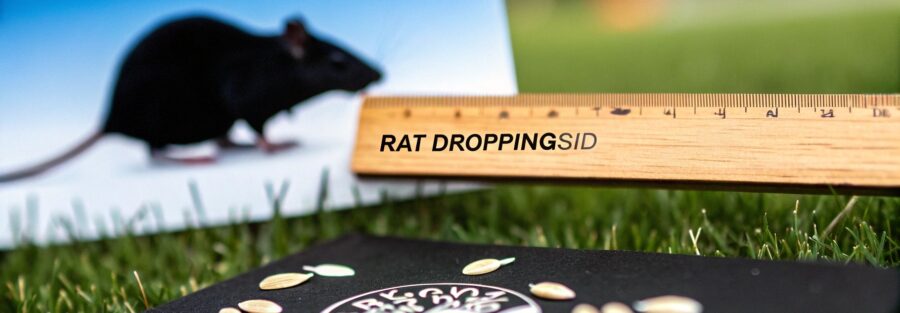When you stumble across droppings in your home, the first thing to look at is their size. It’s the most immediate clue you have to figure out what kind of pest you’re dealing with.
Generally speaking, rat droppings are about the size of a grain of rice or a small bean. In contrast, mouse droppings are much smaller and tend to have more pointed ends. Getting this distinction right is the first, and most important, step in understanding the scale of your pest problem.
What Rat Dropping Size Can Reveal
Think of rodent droppings as a calling card left behind by an uninvited guest. The size of that "card" tells you straight away if you're up against a larger animal, like a rat, or a much smaller one, like a mouse. This is a critical piece of information because the methods for dealing with rats and mice are completely different.
Here in the UK, you’ll find that rat droppings are usually between 12 and 19 millimetres long. That’s noticeably bigger than the tiny 3 to 7 millimetre droppings a house mouse leaves behind. Getting a handle on these measurements is really the foundation of good pest identification.
This visual guide breaks down the size differences clearly, showing you what to look for.
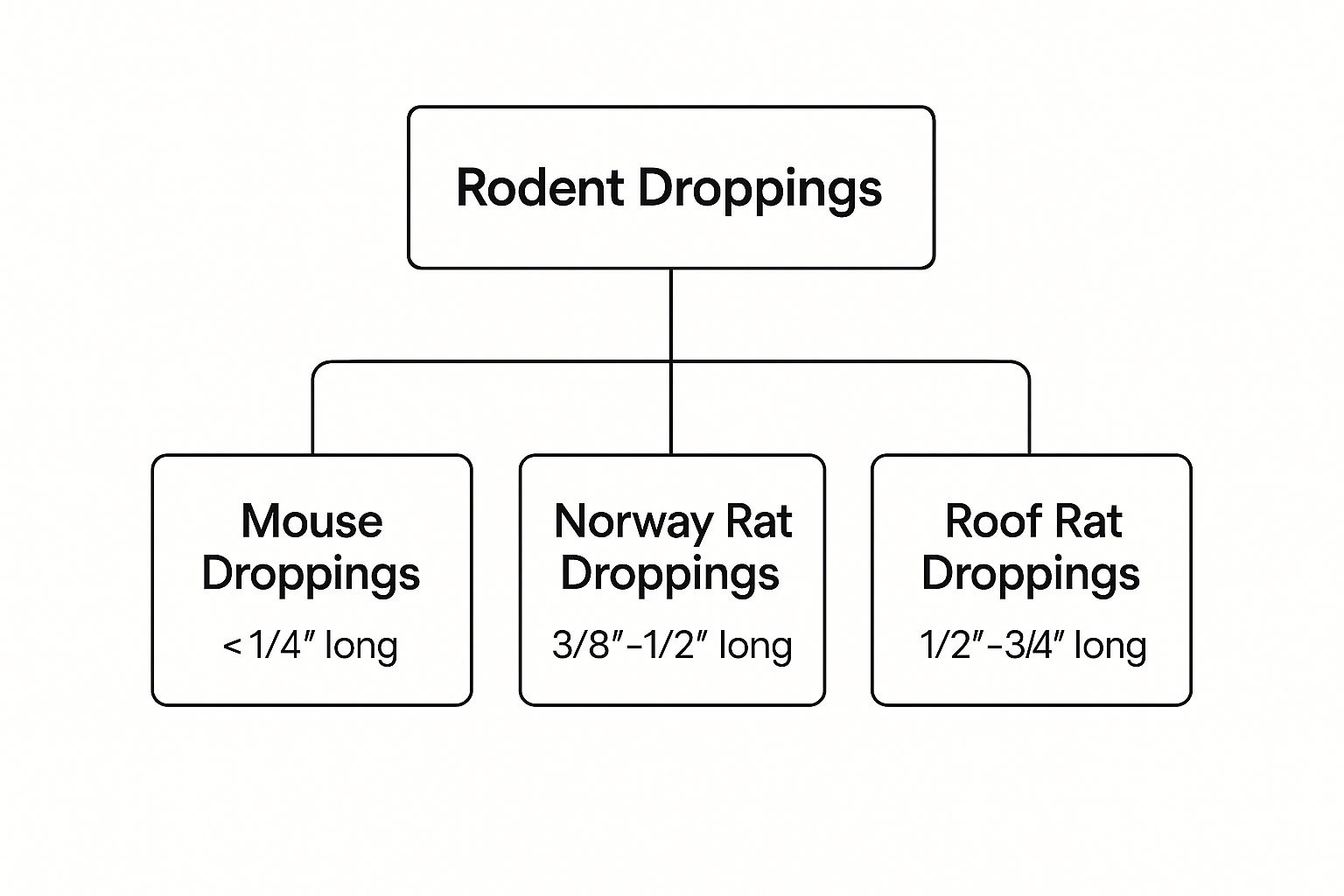
As you can see, both the common Brown Rat (Norway Rat) and the Black Rat (Roof Rat) leave droppings that are substantially larger than those from mice. This confirms that size is your most reliable first clue.
Getting this initial identification right is vital, as it dictates every step you take afterwards. For a more detailed look into their habits and behaviours, have a read of our guide on the difference between mice and rats.
Quick Guide to Rodent Droppings Identification
Sometimes you need a quick reference to be sure. This table lays out the key differences between the droppings of the most common rodents found in UK homes, helping you make a fast and accurate identification.
| Rodent Type | Typical Size (Length) | Shape | Appearance |
|---|---|---|---|
| Brown Rat | 18-19 mm | Spindle-shaped with blunt, rounded ends | Often found in clusters, dark and moist when new |
| Black Rat | 12-15 mm | Curved like a sausage with pointed ends | More scattered, smaller than Brown Rat droppings |
| House Mouse | 3-7 mm | Small, thin, with at least one pointed end | Resembles dark grains of rice, widely scattered |
Using this guide, you can quickly compare what you've found to the typical signs left by each pest. This will give you the confidence to know what you're up against and decide on the best course of action.
Right, so you're pretty sure you're looking at rat droppings. The next question is, what kind of rat are we talking about?
In the UK, it's almost always a face-off between two main suspects: the Brown Rat (Rattus norvegicus) and the much rarer Black Rat (Rattus rattus). Telling them apart is crucial, and thankfully, their droppings give us some solid clues.
What Do the Droppings Look Like?
While all rat droppings are basically cylinder-shaped, the real giveaway is at the ends.
Think of a Brown Rat's dropping as a small, thick capsule – almost like a Tic Tac, but a bit larger and with blunt, rounded ends. They're quite uniform and chunky.
Black Rat droppings, on the other hand, are a bit more delicate. They're thinner, more like a sausage, and usually have distinctly pointed tips. It's a subtle difference, but once you see it, you can't unsee it.
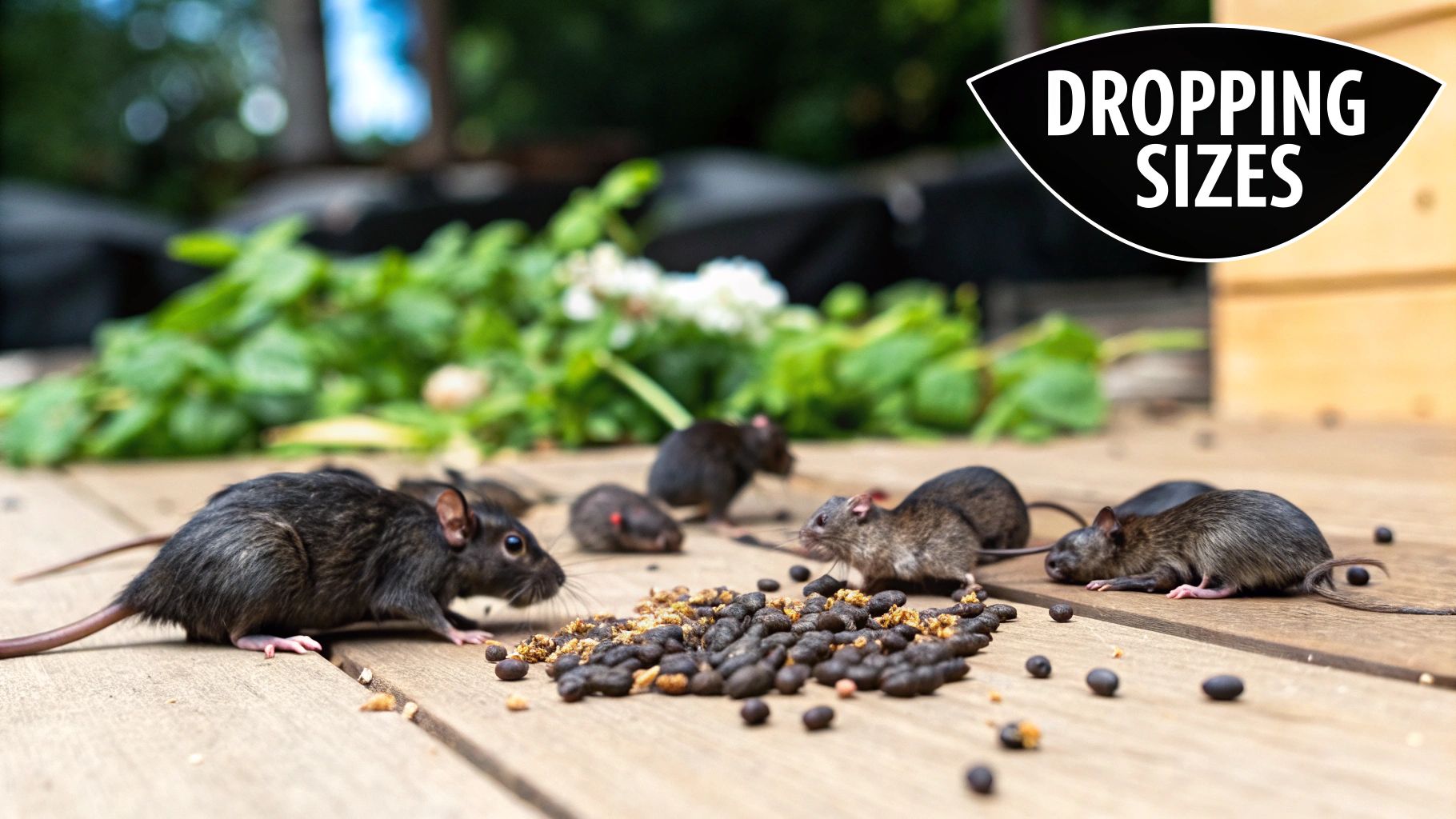
Knowing this isn't just a bit of trivia; it’s the key to understanding how they behave and where they're hiding.
Where You Find Them Tells a Story
The location of the droppings is just as telling as their shape. Each species has its own lifestyle, and that dictates where they leave their mess.
Brown Rats (The Ground-Floor Tenants)
- These are the burrowers and ground-dwellers. They aren't great climbers.
- You’ll almost always find their droppings at lower levels.
- Check behind the fridge, under the kitchen sink, in the cellar, or along skirting boards. They stick to the ground.
Black Rats (The High-Rise Specialists)
- These agile climbers are famously known as 'roof rats' for a reason.
- Their droppings are typically found in elevated spots.
- Have a look in the loft, on top of beams and rafters, or along high ledges in outbuildings.
By putting together the shape of the droppings with where you've found them, you get a much clearer picture of your uninvited guest. A Brown Rat problem needs a completely different strategy to a Black Rat one.
Knowing the species helps create a targeted plan. For Brown Rats, you'd place bait stations along their ground-level runways. For Black Rats, the focus shifts to roof voids and sealing up high-level entry points.
This detail is what makes for successful pest control. Getting the species right from the start is the first and most important step in any effective rodent control and proofing plan, ensuring your efforts hit them where it hurts.
How Droppings Reveal the Scope of an Infestation
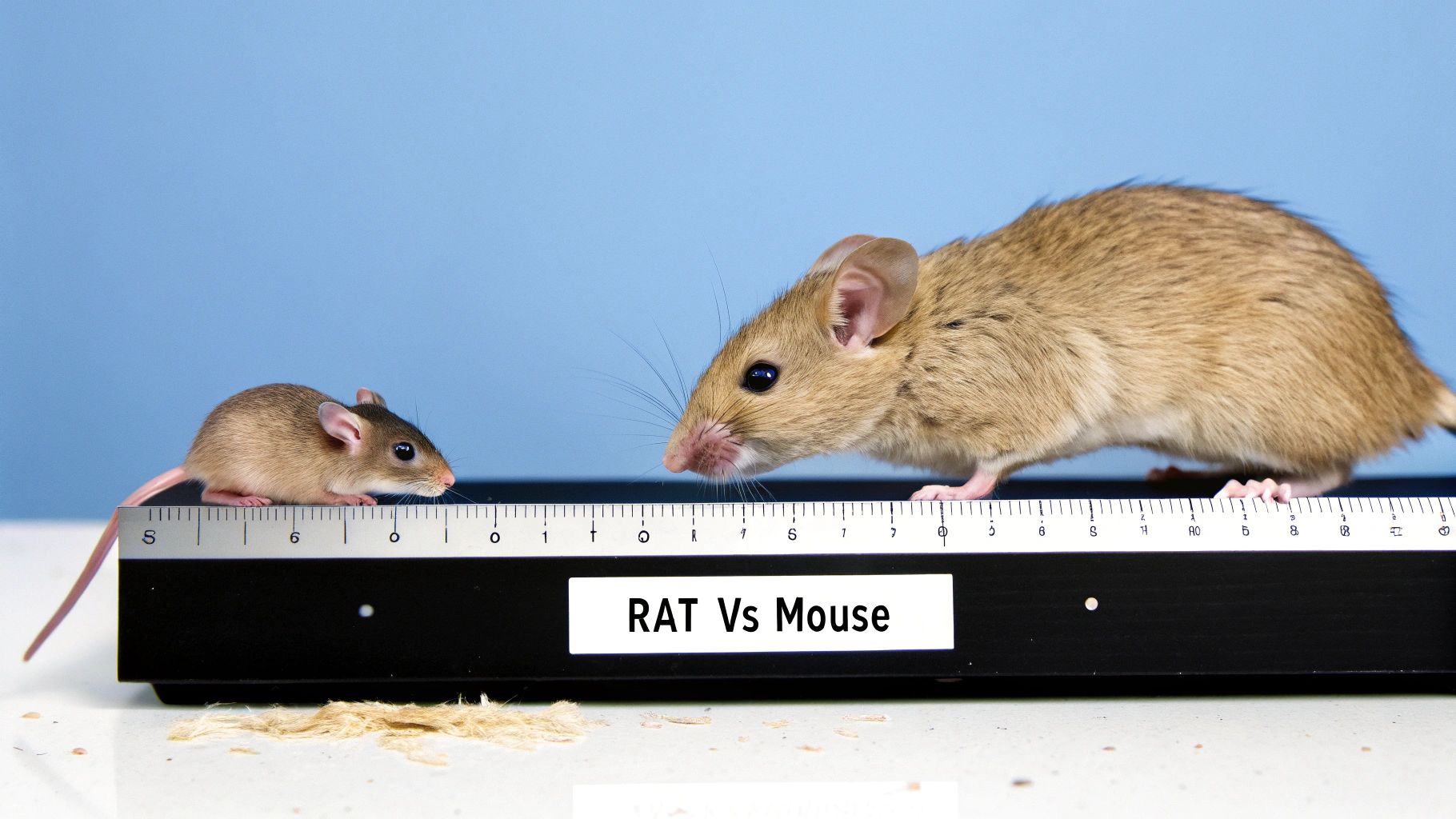
Interpreting the Evidence
Once you're sure you're looking at rat droppings, it's time to put on your detective hat. The amount of droppings you find is a surprisingly direct clue to how many unwanted guests you have.
Finding just a few scattered pellets might mean you've got a single rat scouting out new territory. But if you stumble upon large, concentrated piles, that’s a massive red flag. It tells you you’re right near a nest, a favourite feeding area, or a main rat-run.
This difference is critical because it dictates what you need to do next.
The freshness of rat droppings is like a timestamp. It tells you whether the infestation is a current, active problem or just a ghost of a past one. A few old, dusty droppings are historical evidence, but shiny, dark ones mean the culprits are still very much in residence.
There's a simple test for freshness. If a dropping is soft and putty-like when you prod it (always with a tool, never your hands!), it’s recent. If it just crumbles into dust, it's old news. This single piece of information helps you realise if you're dealing with an ongoing threat.
Using Dropping Count to Estimate Rat Numbers
The sheer volume of droppings can be a bit grim, but it's also incredibly revealing. A single rat can produce up to 40 droppings every single day. Unlike mice, which scatter their droppings everywhere, rats tend to leave theirs in more focused piles, which is a big help for us pest controllers trying to pinpoint hotspots.
This number gives you a solid baseline to figure out the scale of your problem. Here’s a rough guide to what you might be seeing:
- A handful of droppings (10-40): This often points to a single rat that's been active in the area over the last day.
- Multiple small piles: You're probably looking at several rats that have set up regular travel routes through your property.
- Large, continuous mounds: This is a clear sign of a significant, long-term infestation with a well-established nest nearby.
Knowing the difference between a small issue and a major invasion is the key to choosing the right plan of attack. It helps you decide if a few well-placed traps will do the trick or if you need to call in the professionals. Getting a sense of the scale also helps you anticipate the potential cost of professional pest control for rats and budget for it.
How to Tell Rat Droppings Apart from Other Pests
It’s an easy mistake to make, but getting pest droppings mixed up can send you down completely the wrong path for treatment. At a quick glance, a lot of pest evidence can look similar, but rats leave behind some tell-tale signs. Knowing what to look for is the key to figuring out exactly what you’re dealing with.
The most common point of confusion is between rats and mice. As we've seen, the sheer size of rat droppings is the biggest giveaway; they're noticeably larger. Mice also tend to leave a trail of tiny, pointed droppings scattered randomly, while rats are more likely to leave theirs in concentrated piles.
Common Dropping Lookalikes
It's not just other rodents that cause confusion. A few other pests can leave you scratching your head, so it's a good idea to rule them out before you decide it's definitely rats. A quick visual check is often all you need.
- Squirrel Droppings: These are often mistaken for rat droppings but tend to be thicker and more barrel-shaped. They also often have a lighter brown or even reddish colour and, as you'd expect, are usually found in lofts, attics, or around the outside of your home.
- Cockroach Droppings: These are tiny and look a lot like specks of black pepper or coffee grounds. Larger cockroaches can produce more cylindrical droppings, but they'll have distinctive ridges running down the sides—something you'll never see on rat faeces.
The fact that rat droppings are often double the length of mouse droppings is a crucial detail. This isn't just a casual observation; it's a key factor for professionals, especially when it comes to regulatory compliance in places like restaurants or for urban health management.
For this reason, UK pest management guidelines actually stress the importance of measuring droppings. Getting a ruler or even just a coin out can help you make a quick, accurate ID on the spot. You can learn more about these professional standards by exploring UK environmental guidelines.
A coin is a brilliant, simple tool for getting a sense of scale. If you place a penny next to the droppings, you can immediately see how they measure up against the typical sizes for rats, mice, or squirrels. It’s a small step that gives you the confidence to know you’ve identified the right pest.
Health Risks and Safe Cleanup Procedures
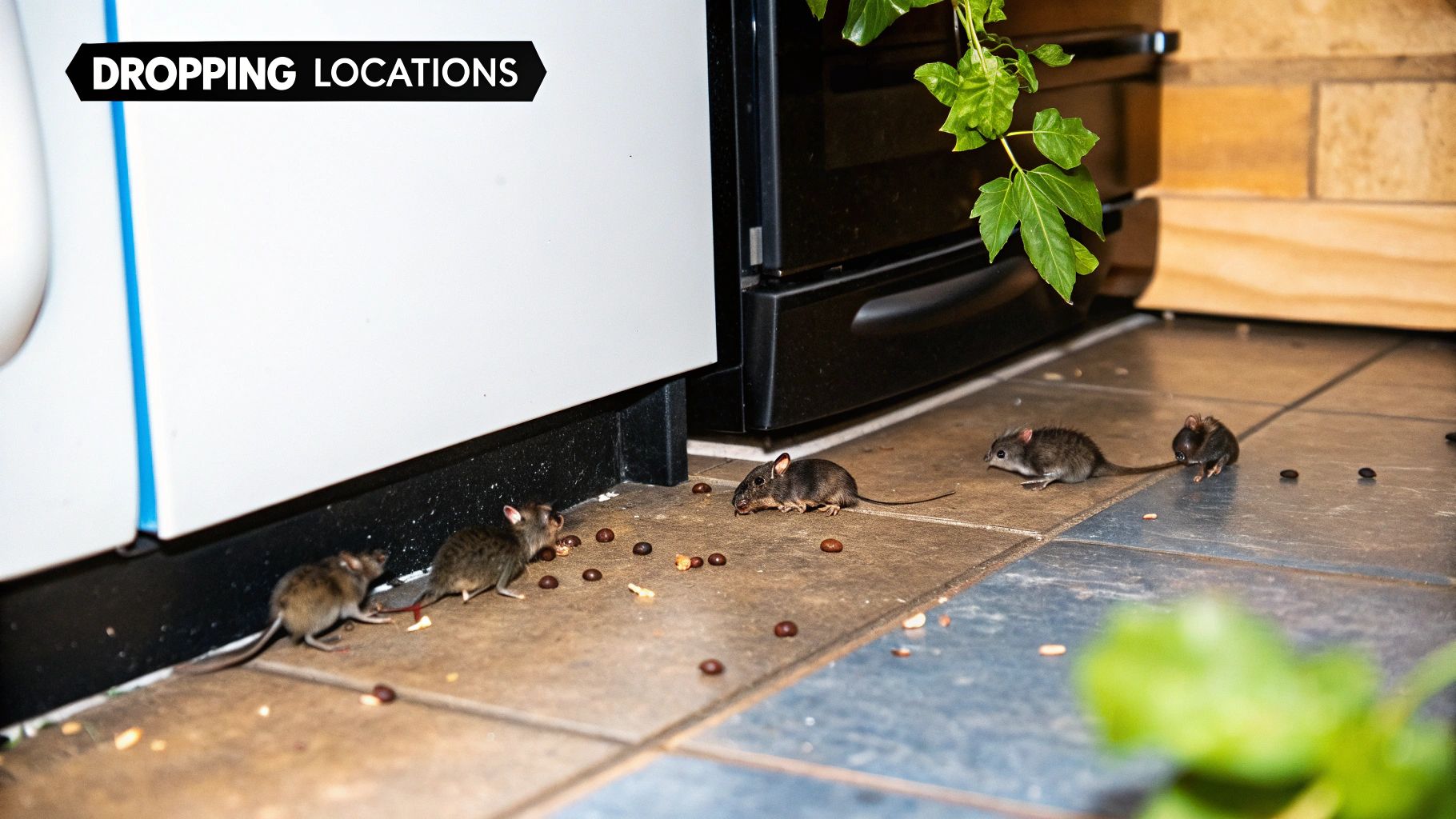
It’s easy to dismiss rat droppings as just a disgusting mess, but they carry some serious health risks. These droppings can be loaded with pathogens that cause nasty illnesses like Salmonellosis and Leptospirosis, which can easily spread to people and pets.
The real danger often lies in how you clean them up. The absolute worst thing you can do is sweep or vacuum dry droppings. This kicks up all the harmful particles, turning them into an airborne mist of bacteria and viruses that you can breathe right in. You have to be methodical to protect yourself.
A Step-by-Step Guide to Safe Removal
To clean up rat droppings without putting your health on the line, you need to create a proper barrier between yourself and the contaminants. Follow these steps carefully.
- Gear Up: First things first, get protected. Put on a pair of rubber gloves and a good quality face mask to avoid skin contact and breathing in anything nasty.
- Air It Out: Open up any nearby windows and doors for at least 30 minutes before you start. This gets fresh air circulating and helps disperse any airborne particles.
- Soak, Don't Sweep: Make up a disinfectant solution – a 1:10 bleach-to-water mix works perfectly. Spray this directly onto the droppings and the surrounding area until they're completely soaked. Let it sit for about five minutes to kill off the pathogens.
- Wipe and Bin: Now, use disposable paper towels to wipe everything up. Place the soiled towels and your used gloves straight into a plastic bag, seal it tightly, and throw it in your outdoor bin.
Tracking droppings is a vital part of figuring out the scale of an infestation and where the rats are moving. A single rat can leave behind 30 to 50 droppings in a single night, giving pest control experts the clues they need.
After you’ve cleared away the droppings, the job isn't quite done. You’ll need to thoroughly sanitise the entire area. For large-scale infestations or commercial properties where a deep clean is essential, it’s often best to call in professional commercial disinfection and sanitizing services to make sure the environment is completely safe.
Still Have Questions About Rat Droppings?
So, you’ve found something suspicious, but you're not quite sure what it means. That's perfectly normal. When it comes to pests, a bit of detective work is always needed. Let's tackle some of the most common questions people have when they find what they think might be rat droppings.
A Few Droppings vs. a Full-Blown Infestation
Finding one or two droppings is often the first sign, but does it mean your home is overrun? Not always. It could just be a single rat passing through, scouting for a new place to call home.
But here’s the thing: rats are prolific. A single rat can leave behind up to 40 droppings every single day. Even a small discovery is a big red flag that you need to act, and act fast, before that lone scout invites its friends over.
Do All Old Rat Droppings Turn Grey?
There's a common myth that all old droppings eventually turn grey. While they certainly get lighter and dustier over time, the exact colour depends on what the rat has been eating.
A much better way to judge the age of droppings is by their texture. Fresh droppings are dark, glossy, and soft, almost like putty. Older droppings, on the other hand, will be dry and brittle, crumbling to dust if you were to touch them (which, of course, you should only do with gloves on!).
Common Hiding Spots and When to Call for Help
Rats are clever and secretive. They love to set up shop in dark, quiet places that are still close to a food source. If you're on the hunt for more evidence, these are the first places you should check.
- In the Kitchen: Pull out the fridge and cooker. Look deep inside the back of low-level cupboards and under the sink.
- Lofts and Cellars: These are prime real estate for rats. Check the corners, along the rafters, and inside any old boxes you have stored away.
- Inside Walls: The cavities between your walls are like hidden motorways for rats, allowing them to move around the house unseen.
So, is this a job you can handle yourself? If you’ve only found a couple of droppings and feel up to setting some traps, a DIY approach might be enough to nip the problem in the bud.
But if you're seeing large amounts of droppings, finding gnaw marks on wood or wiring, or hearing those unmistakable scratching sounds at night, you're past the point of a simple DIY fix. That’s a sign of a well-established infestation.
When a rat problem feels like it's getting out of hand, it's best not to wait. The experts at Pest Predators Limited use proven, eco-friendly methods to get your home back to normal. Contact us today for a professional assessment and a lasting solution.

